Change management models are a business necessity because change is always inevitable. You may have to make transitions that other stakeholders, managers, or leaders are only partially on board with from the start.
You may face change due to:
-
Economic uncertainty.
-
Market changes.
-
Technology changes.
If you follow change management methodologies, you’ll have an easier, more efficient time with organizational change. Leaders who must make integral changes inside their organizations should consider change management a viable path forward.
Definition and importance of change management
Successful change starts with a systematic approach from the current to the desired state of the business. A change management framework allows for the transitioning of teams and individuals with:
-
Less resistance.
-
Successful implementation.
Methodologies vary from one model to the next, but each model’s goal is similar and includes a defined vision, strategy, and plan. Once you have these three elements in place, the model will help you communicate with your team, create teams, allocate resources properly, set employees up for success, lead the program, and reinforce the program to ensure its longevity in the business.
Your organization’s challenges will vary based on culture, location, structure, and market.
For example, if you integrate new tools like HelpDesk into your organization, change management models will help you manage resources, training, and internal and external factors.
Ultimately, the model you choose will help you adapt to the change faster, thanks to proper planning.
If the integration of significant organizational changes doesn’t go smoothly, it can lead to higher turnover and lost customers. 70% of change initiatives fail because there is no blueprint to follow (source).
Check how HelpDesk can help your team. Join our free 14-day trial right now! 🔥
Brief history of change management
You cannot avoid change, and while modern models may be newer, the concepts have been around for decades. Early change management models started to appear in the 1940s and 1950s, but they were less popular than today.
It wasn’t until 1990-2000 that change management evolved to include the foundational elements we see today with theories, best practices, and models organizations worldwide use.
C-suite executives have started using the models we’ll review today for everything from customer service management to strategic project management changes. Understanding the change ahead can help leaders offer a streamlined, hassle-free implementation.
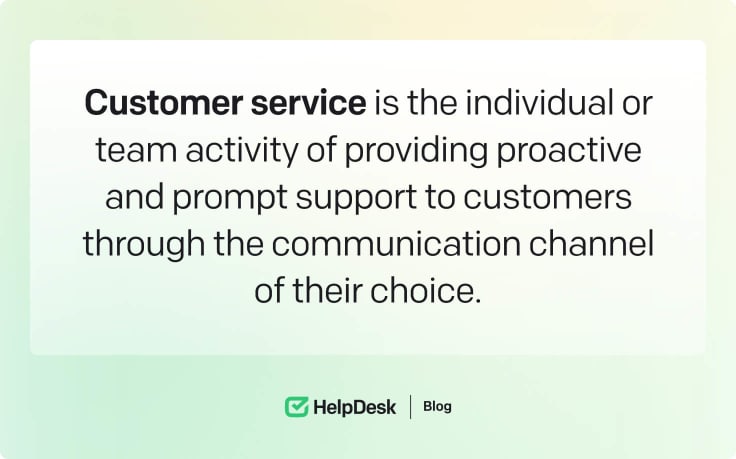
Understanding organizational change
Change falls into three main types, and popular change management models aim to address all of them. Selecting the suitable model for your business should be done based on one of the following types of organizational change:
-
Structural change: An organization undergoing a merger, restructuring, or acquisition falls under the structural change classification.
-
Cultural change: When changing your values, norms, or internal culture change, you also need a framework in place. Employees may push back against some of these changes, and you’ll need to consider their emotions, too.
-
Procedural change: Systems and processes evolve, with new solutions being phased in as new tools emerge. Whether you’re integrating contact management software or new workflows, procedures must change, and a framework can help.
Small businesses with a handful of workers can bypass using a change management model. Still, the need to use a framework will increase as the organization grows.
Learn more about contact management software in our latest HelpDesk blog article. Check this out! 🧑🚀

Why change management is essential for success
You must remain agile to internal and external factors that impact your business and may help competitors become more efficient.
You’ll have to deal with:
-
Market shifts.
-
Technical advancements.
If your changes disrupt your operations, it can lead to customer loss, lower revenue, and a damaged reputation. Change management methodologies maximize the benefits of change while reducing the side effects that can occur with poor implementation.
Popular change management models
Each change management model offers unique benefits, but the following are among the most popular.
Lewin’s Change Management Model
Kurt Lewin’s theory follows a chunk-based concept, breaking change down into three phases:
-
Unfreeze.
-
Change.
-
Refreeze.
One of the benefits of this model is that you prepare for change before the implementation process, allowing everyone to have a greater appreciation for the changes ahead before implementing them.
The theory was founded in the 1940s, yet it remains a viable option over 80 years later.
For example, during the unfreeze phase, you’ll decide what changes are necessary, discuss them with your team, and analyze them. You’ll then integrate the changes, explain their benefits, and even train employees to utilize them best.
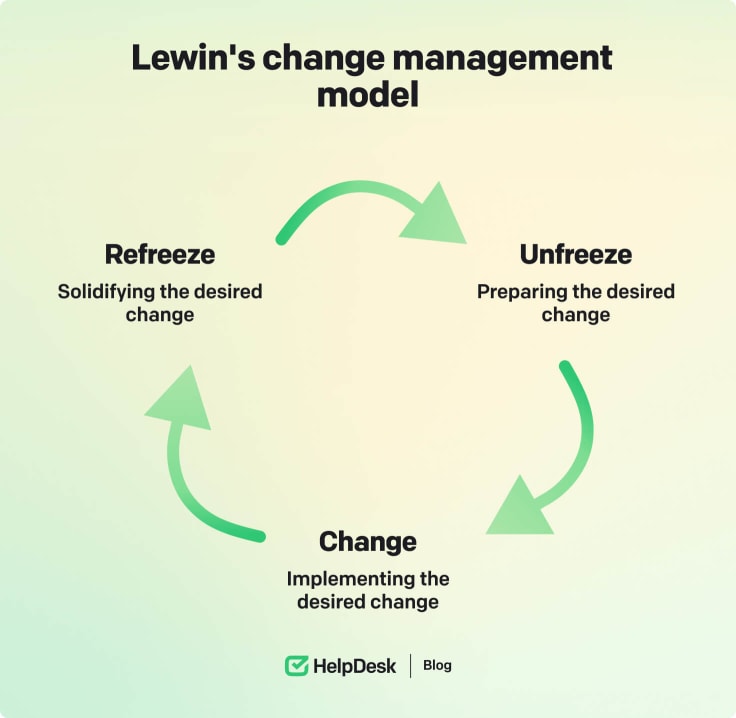
Classic change management models
Classic change models are time-tested and known for offering a framework that facilitates the realization of strategic visions.
The McKinsey 7-S Model
7-S is a complex model — there’s no way around it — but if a major change is going through that can’t be solved with a handbook, you may need to address the following:
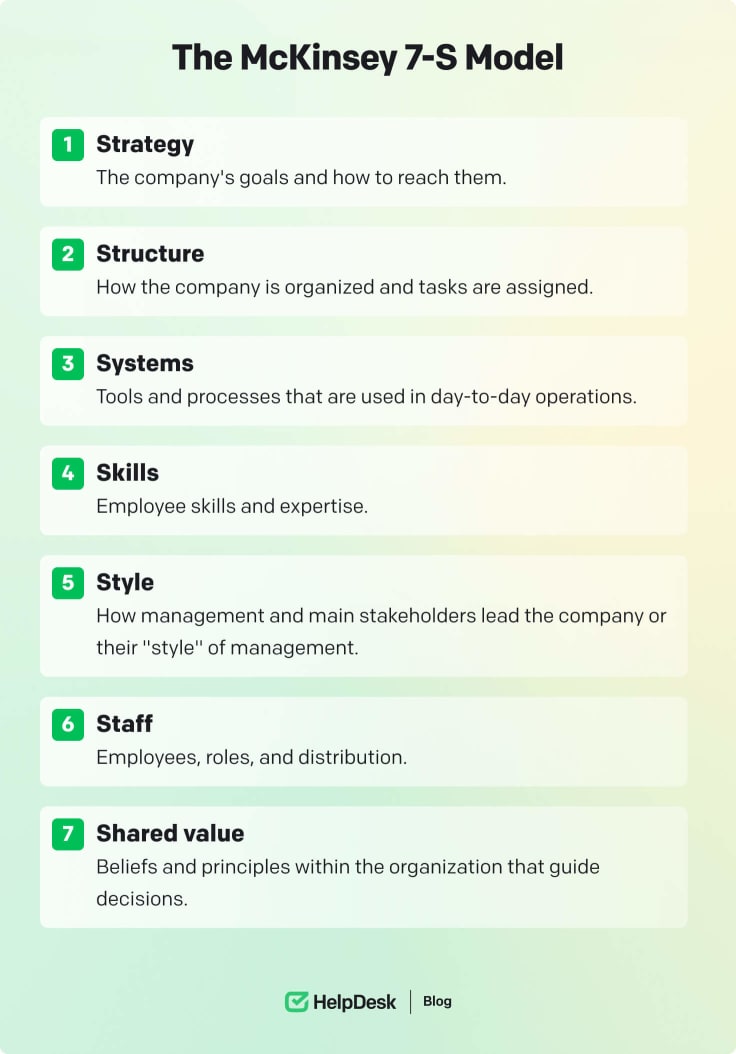
Organizing these elements also occurs in bunches, with the first three considered the foundation: strategy, structure, and systems. These three elements must exist for all changes, but the remaining four are more about ensuring these changes go smoothly.
Kotter’s change management theory
Dr. John P. Kotter focuses on the people involved in the change and the psychology involved. The steps provide an approach for change management, create urgency, build a coalition, and create short-term “wins” to stay on track.
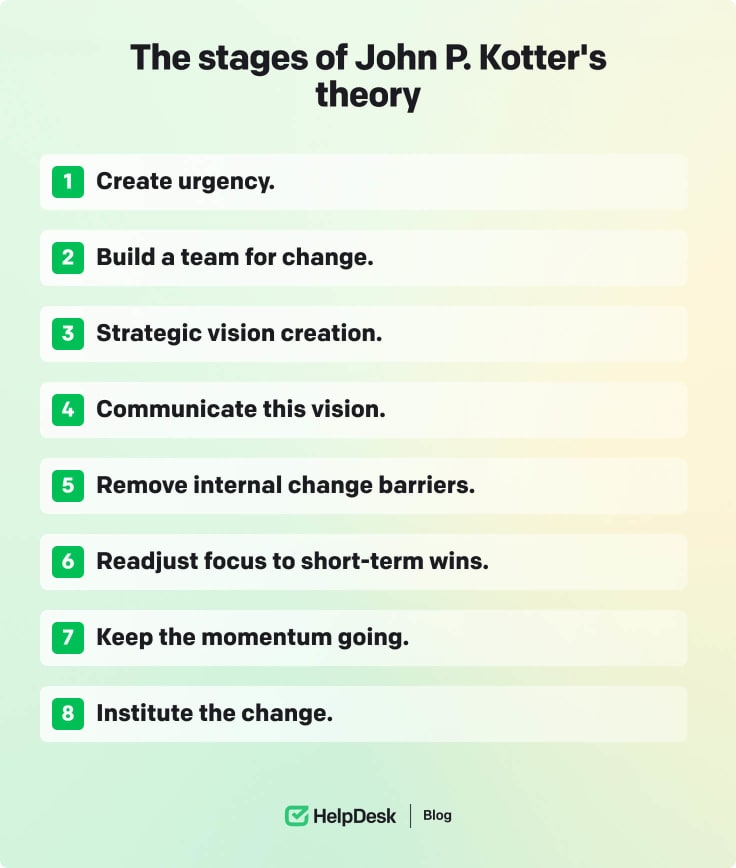
This model is worth following if you must create enthusiasm within your team that will be pivotal to your success. Larger organizations have an easier time with the Kotter theory than smaller businesses.
Individual change management models
An individual management model addresses and manages change at the individual level. Two primary models fall under this category: ADKAR and the Kübler-Ross Change Curve.
The ADKAR model
The ADKAR model, created by Prosci founder Jeff Hiatt, takes a goal-oriented approach to ensuring a successful change. Under this model, individual employees must achieve five outcomes:
-
Awareness. Employees are informed about the change and the benefits it will offer.
-
Desire. Leaders provide case studies and other evidence to excite the team about the change.
-
Knowledge. Employees go through training to learn how to implement the new changes.
-
Ability. After training, employees can now apply what they’ve learned.
-
Reinforcement. Leaders reinforce the positive outcome of the change and its benefits by recognizing employees for their accomplishments.
The achievement of these five goals will help your team build confidence and capacity, which will make them more confident during the transition phase.

The Kübler-Ross Change Curve
The Kübler-Ross Change Curve is based on the five stages of grief pioneered by psychiatrist Elisabeth Kübler-Ross in the 1960s. So, this model expands on these stages to describe employees’ emotions when going through a change.
These stages include:
-
Shock
-
Denial
-
Frustration
-
Depression
-
Experiment
-
Decision
-
Integration
The Kübler-Ross Change Curve model can help organizations prepare for and address employee emotions during a change. However, it should be paired with another model because it doesn’t provide a framework for planning and implementing a change.
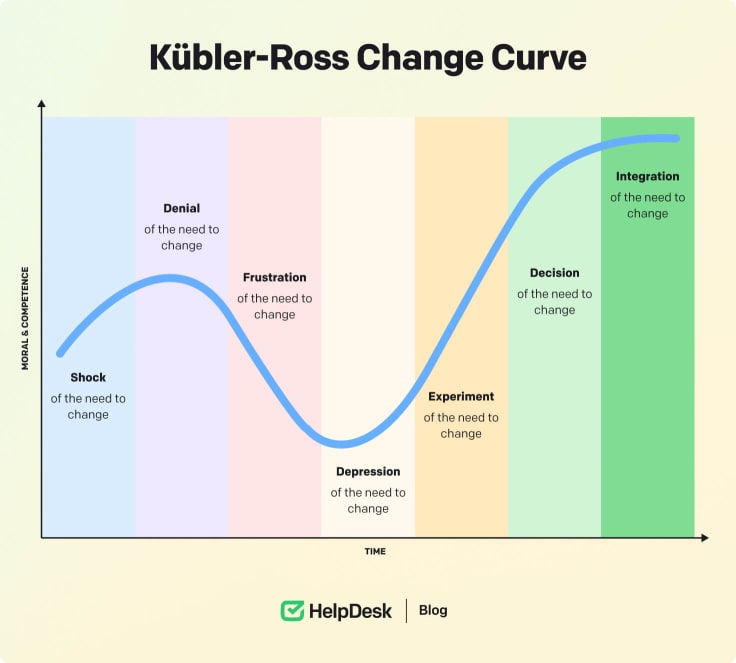
Transition change management models
Transitional changes are often more extensive than developmental shifts because, in many cases, you’re replacing an existing system with an entirely new one. Although major changes such as these are less frequent, they can impact company culture and present many challenges.
Bridges’ Transition Model
William Bridges created this transition model, focusing on the human experience and emotional reaction to transition.
According to Bridges, the process isn’t about change but rather a transition. Changes happen abruptly, and you have no control over them. A transition, however, is a journey.
Understanding and anticipating the emotions your employees may experience (denial, anger, frustration, etc.) will make it easier to build a bridge between old and new systems.
Bridges’ Transition Model breaks the transition into three stages:
-
Ending. Employees know what they’ll lose in the transition, whether a software platform or their colleagues.
-
The neutral zone. It’s the period between the old and new systems. Your employees may need clarification on their responsibilities or the new methods you plan to implement.
-
The new beginning. Employees accept the change as the new norm.
This model is about managing employee emotions as you transition, so it should be paired with a complex model that provides a framework for making the desired change.
Considering your employees’ emotions when implementing changes will give you a much higher acceptance rate.
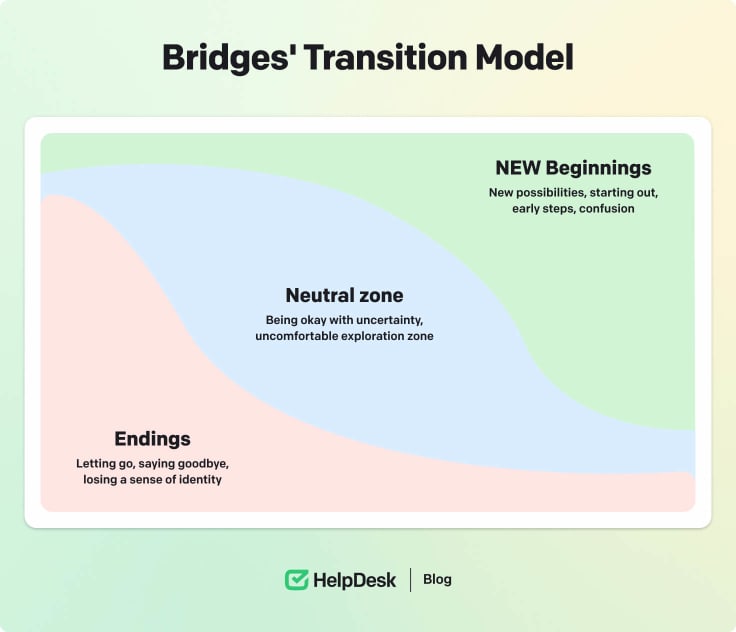
The Satir Change Model
Developed by therapist Virginia Satir, this model, based on the five stages of grief, was initially intended to study how families go through change. Today, it is used as a transition change management model in organizations worldwide.
The Satir Change Model is related to the Kübler-Ross Change Curve in that it monitors employee emotions by tracking their performance throughout the five grief stages.
-
Late status quo. Employees know and understand that a change is coming but may also be frustrated, dissatisfied, or disappointed.
-
Resistance. It’s the first stage after the change is introduced. Employees may be resistant to the change and need clarification on its effects. Productivity may decrease, and there may be frustration, anger, or denial.
-
Chaos. The old system has been dismantled at this stage, but the new one has yet to take its place. Productivity may reach its lowest point. This is the stage where you’ll want to provide the most support to your team.
-
Integration. Employees are starting to see the value and benefits of the change, and productivity should start to improve.
-
New status quo. At this stage, employees have accepted the change as the new norm and fully integrated it into their work.

Implementing a change management model
Now that you understand change management methodology better, the next step is implementing the best model for your organization.
Finding the right model is crucial, and several factors must be considered.
Type of change
Are you trying to make a cultural, structural, or procedural change?
-
The focus should be on your employees’ emotional needs for cultural changes. Individual change management models like ADKAR or the Kübler-Ross Change Curve may work best.
-
A model that combines those used for cultural change with a system that focuses on planning and management is ideal for structural changes. Organizations prefer classic change management strategies like Kotter’s Change Management Theory or the McKinsey 7-S Model.
-
For procedural changes, you might prefer a model that helps you identify what needs to be changed and make minor adjustments. Lewin’s Change Management Model, Kotter’s Theory, or the McKinsey 7-S Model may work well for this purpose.
Find out how our customer manages multiple brands with 56 teams in one system.
Employee needs and organizational culture
When deciding on a change, it’s essential to consider your employees’ needs and your organization’s culture.
Your goal should be to choose a model that aligns with your organization’s goals and strategic vision while meeting the needs of staff and leaders.
Tips for successful implementation
Deciding on a model is the first step. How can you ensure the successful implementation of your change management model?
Here are some tips:
-
Prioritize communication. Ensure that everyone understands the need for and benefits of the change management model.
-
Engage your employees in the change process. The more engaged they are, the higher the chances of success. Be sure to provide ample training and support to your team.
-
Continue to monitor and evaluate the effectiveness of our change management model. Be bold and change strategies if your model needs to deliver the desired results.
Remembering that you may need to combine models to address the change’s planning and management and your employees’ reaction to it is indispensable.
Take care of your customers even better. Try HelpDesk for 14 days for free! 🚀
Summary
Change is unavoidable in business. However, it can be challenging for the organization and its employees.
Employees may feel frustrated or angry and a poorly planned transition can lead to failure. Change management models are designed to address employee emotions and help organizations transition successfully.
It’s crucial to find a suitable model for your organization. Consider the tips above, and weigh the pros and cons of each model to find the proper framework for your business.


